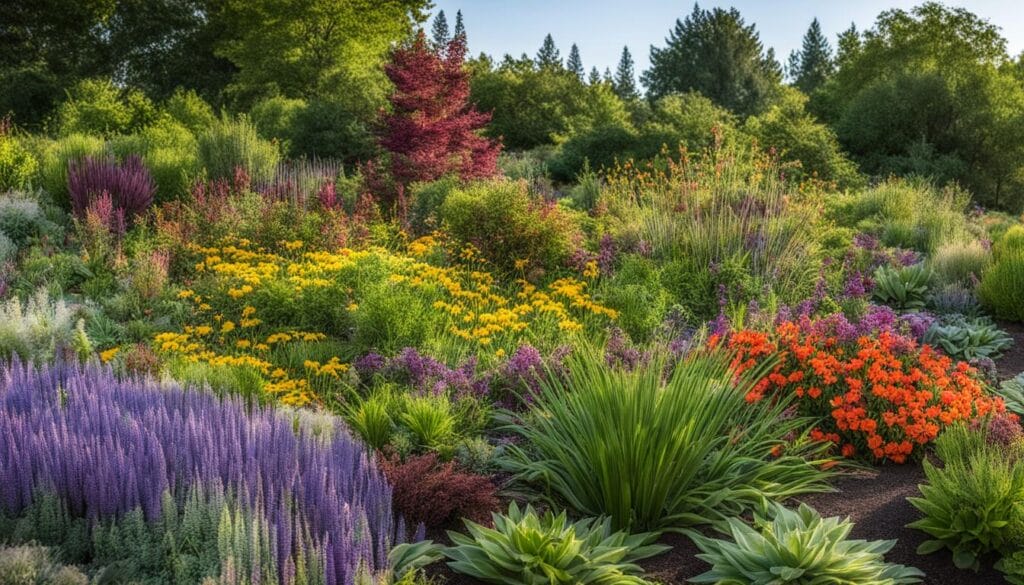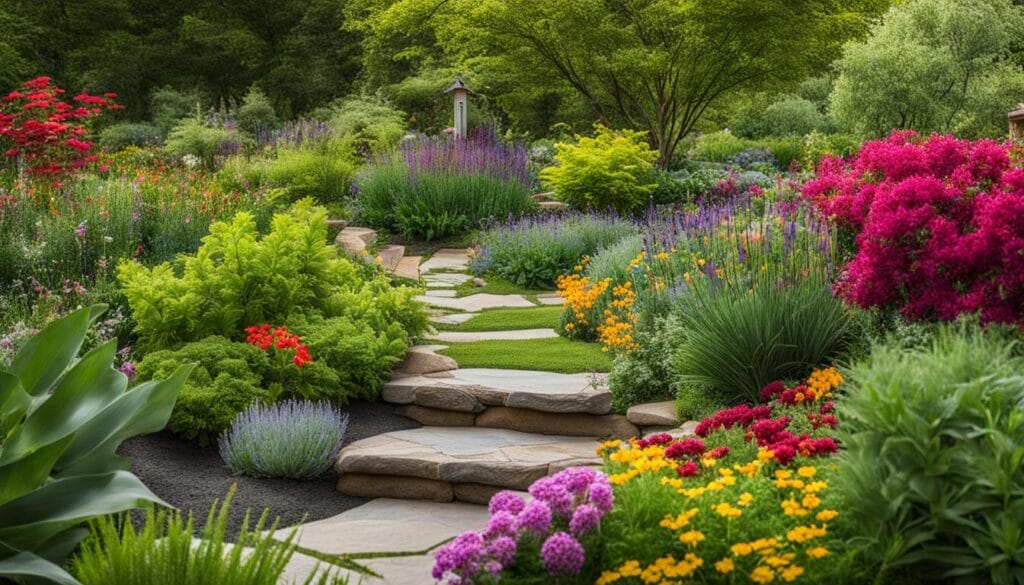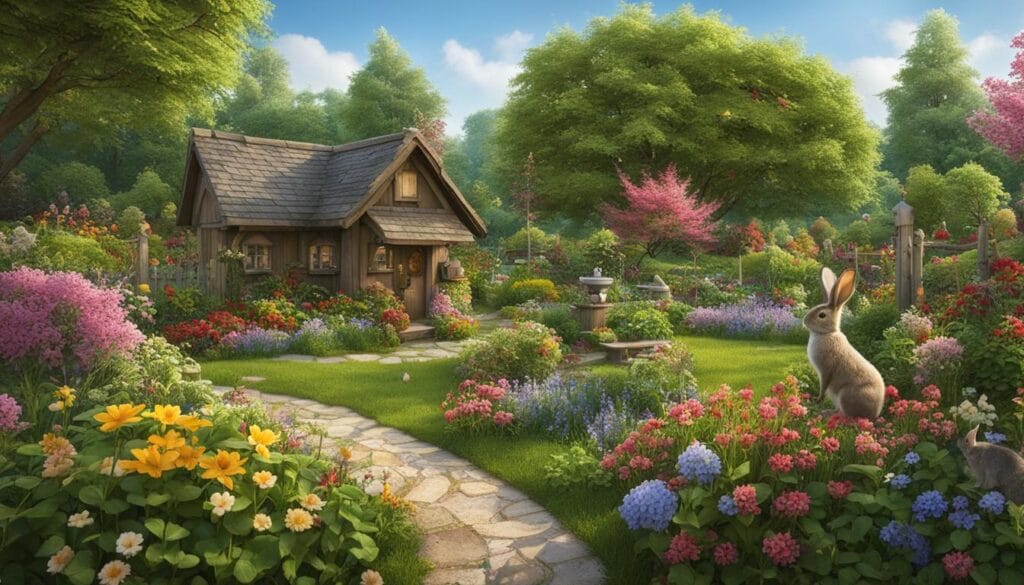Are you looking to enhance the biodiversity of your garden? Incorporating native plants is a sustainable and effective way to promote a thriving ecosystem right in your backyard. Native plants are well-adapted to the local climate and soil conditions, making them low-maintenance and water-efficient options. Not only do they require less care, but they also provide essential habitat and food sources for local wildlife, contributing to the overall biodiversity of your outdoor space.
Key Takeaways
- Choose native plants for your garden to increase biodiversity
- Native plants require less water, fertilizer, and maintenance
- Native plants provide essential habitat and food sources for local wildlife
- Creating diverse ecosystems promotes a healthy and balanced environment
- Sustainable hardscaping can also contribute to garden biodiversity
Benefits of Native Plants for Biodiversity
Native plants have numerous benefits when it comes to increasing garden biodiversity. These plants have evolved over time to adapt to the local climate and soil conditions, making them perfectly suited for the ecosystem in which they grow. By incorporating native plants into your garden, you provide essential habitat and food sources for local wildlife such as birds, bees, and butterflies. Native plants attract beneficial insects and pollinators, creating a thriving and diverse community of organisms.
One of the key advantages of native plants is their low maintenance requirements. They are well-adapted to the local environment, which means they typically require less water, fertilizer, and maintenance compared to non-native species. By choosing native plants, you can save time and resources while still promoting garden biodiversity.
Furthermore, native plants play a crucial role in conserving water resources. Their natural adaptations allow them to withstand local climatic conditions, making them more drought-tolerant. This reduces the need for excessive watering and helps conserve water, which is especially important in areas experiencing water scarcity. By incorporating native plants into your garden, you can contribute to water conservation efforts while supporting biodiversity.
“Native plants attract beneficial insects and pollinators, creating a thriving and diverse community of organisms.”
| Benefits of Native Plants for Biodiversity |
|---|
| Provides essential habitat and food sources for local wildlife |
| Attracts beneficial insects and pollinators |
| Requires less water, fertilizer, and maintenance |
| Conserves water resources |
By incorporating native plants into your garden, you not only create a visually appealing landscape but also contribute to the overall health of the environment. Native plants are a sustainable choice that promotes biodiversity, conserves resources, and supports local wildlife.
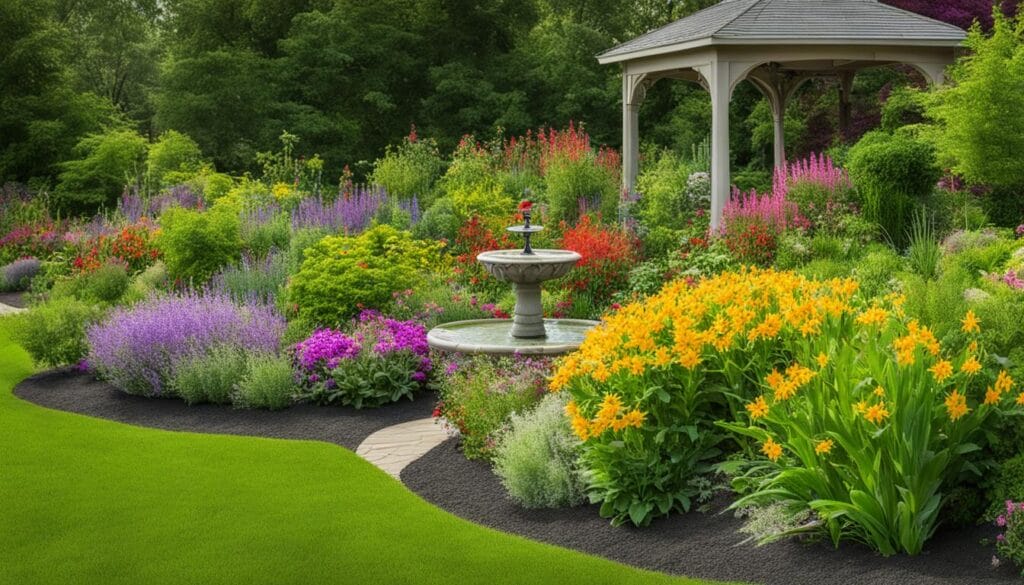
Strategies for Increasing Biodiversity with Native Plants
Increasing garden biodiversity through the use of native plants is not only beneficial for the environment but also enhances the overall beauty and health of your outdoor space. By implementing the following strategies, you can create a thriving ecosystem that supports a wide range of wildlife and contributes to the conservation of biodiversity.
1. Select a Diverse Range of Native Plants
Choosing a variety of native plants is essential for creating a biodiverse landscape. Select plants that bloom at different times throughout the year to provide a continuous source of nectar and pollen for pollinators. This diverse range of flowering periods ensures that there is a constant food supply available for bees, butterflies, and other beneficial insects.
2. Create a Layered Planting Design
A layered planting design with plants of varying heights and structures offers different types of habitats and shelter for wildlife. Taller plants provide perches for birds, while shorter groundcover plants create hiding spots for small mammals and insects. By incorporating a variety of plant sizes and structures, you can maximize the potential for attracting and supporting a wide array of species.
3. Include Plants that Produce Berries or Seeds
Adding plants that produce berries or seeds to your garden provides a valuable food source for birds and small mammals. Species such as hollies, dogwoods, and coneflowers are excellent choices for attracting wildlife with their nutritious fruits and seeds. These plants not only provide sustenance but also contribute to the overall biodiversity of your garden.
| Plant | Benefits |
|---|---|
| Hollies | Attracts birds with its vibrant berries |
| Dogwoods | Provides food and shelter for birds and small mammals |
| Coneflowers | Offers nectar-rich flowers for pollinators |
4. Adopt Organic and Integrated Pest Management Techniques
By avoiding the use of chemical pesticides and herbicides, you can protect beneficial insects and promote a healthy ecosystem. Instead, opt for organic pest control methods such as companion planting, biological controls, and physical barriers. Integrated pest management techniques can help maintain a balanced garden ecosystem while minimizing the negative impact on biodiversity.
By implementing these strategies, you can effectively increase biodiversity in your garden with native plants. Remember to choose a diverse range of plants, create a layered planting design, include species that produce berries or seeds, and adopt organic pest management techniques. By doing so, you can create a thriving ecosystem that supports a variety of wildlife and contributes to the overall health of the environment.
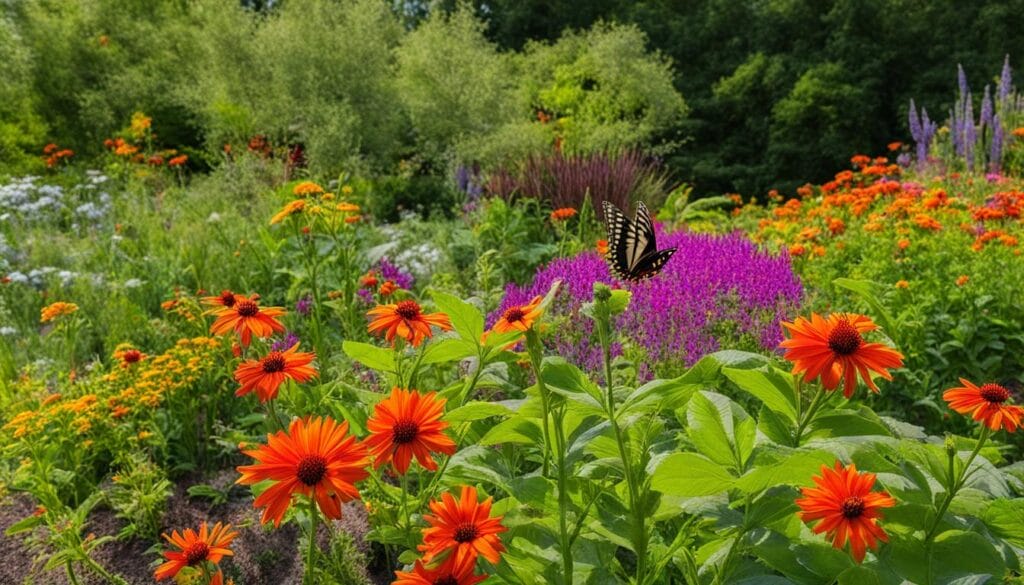
Designing Water-Smart Landscapes for Biodiversity
When it comes to increasing garden biodiversity, designing water-smart landscapes is a crucial consideration. With water scarcity becoming an increasingly pressing issue, it’s important to incorporate strategies that promote both biodiversity and water conservation. By implementing water-saving features and using native plants suited to the local climate, you can create a landscape that supports a thriving ecosystem while minimizing water usage.
One key strategy for designing water-smart landscapes is to incorporate features such as rain gardens, bioswales, and permeable paving. These elements help capture and efficiently use rainwater, reducing the need for excessive irrigation. Rain gardens, for example, are designed to collect and absorb rainwater, allowing it to naturally infiltrate the soil. This not only reduces runoff but also helps replenish groundwater and supports the growth of native plants.
Choosing native plants that are well-adapted to the local climate and soil conditions is another important aspect of water-smart landscaping. Native plants require less water compared to non-native species, as they have evolved to survive in the specific environmental conditions of the region. By opting for native plants, you can significantly reduce water requirements while still promoting biodiversity in your garden.
Table: Water-Saving Features for Biodiversity
| Water-Saving Feature | Description |
|---|---|
| Rain Gardens | Designed to collect and absorb rainwater, allowing it to naturally infiltrate the soil. |
| Bioswales | Channels that help manage and filter stormwater runoff, promoting groundwater recharge. |
| Permeable Paving | Porous surfaces that allow rainwater to seep into the ground, reducing runoff and preventing erosion. |
| Drip Irrigation | A targeted irrigation system that delivers water directly to plant roots, minimizing waste. |
Furthermore, utilizing efficient irrigation systems like drip irrigation can help minimize water waste. Drip irrigation delivers water directly to the plant’s roots, reducing evaporation and ensuring that water is used efficiently. Additionally, smart controllers that adjust watering schedules based on weather conditions can further optimize water usage, ensuring that plants receive the right amount of moisture without unnecessary waste.
By designing water-smart landscapes and incorporating native plants, you can create a biodiverse garden that not only supports local wildlife but also conserves water resources. These sustainable practices not only benefit the environment but also contribute to the overall beauty and resilience of your outdoor space.
Creating Healthy Ecosystems for Biodiversity
In order to promote biodiversity in your garden, it is essential to create healthy ecosystems that provide a range of habitats and resources for different wildlife species. By incorporating a variety of native plants, you can attract and support a diverse community of organisms, including birds, bees, butterflies, and other beneficial insects.
Benefits of Native Plants for Biodiversity
Native plants play a crucial role in increasing garden biodiversity. They have evolved in specific regions and have developed unique adaptations to survive in local ecosystems. By incorporating native plants into your garden, you can provide essential habitat and food sources for local wildlife. Native plants also support the ecosystem by attracting beneficial insects and pollinators, which in turn promote a healthy and diverse community of organisms. Additionally, native plants require less water, fertilizer, and maintenance, making them a sustainable choice for increasing garden biodiversity.
When selecting native plants for your garden, consider choosing a variety of species that bloom at different times throughout the year. This will provide a continuous source of nectar and pollen for pollinators. Creating a layered planting design with plants of varying heights and structures can offer different types of habitats and shelter for wildlife. Including plants that produce berries or seeds can provide food sources for birds and small mammals, further enhancing biodiversity in your garden.
It is also important to avoid the use of chemical pesticides and herbicides in your garden. Instead, opt for organic and integrated pest management techniques to protect beneficial insects and maintain a balanced ecosystem. By focusing on creating healthy and diverse ecosystems, you can increase garden biodiversity and contribute to the overall health of the environment.
| Native Plants for Biodiversity | Benefits |
|---|---|
| Goldenrod | Provides nectar and pollen for bees and butterflies |
| Echinacea | Attracts birds and pollinators with its vibrant flowers and seed heads |
| Black-eyed Susan | Offers nectar and pollen for bees and butterflies |
| Milkweed | Serves as a host plant for monarch butterflies and provides nectar for other pollinators |
“Incorporating native plants in your garden not only enhances its beauty but also creates a thriving ecosystem that supports a wide range of wildlife. By providing food, shelter, and habitat for birds, pollinators, and other beneficial insects, you can contribute to the conservation of biodiversity in your own backyard.” – Landscape Professional
Sustainable Hardscaping for Biodiversity
When it comes to increasing biodiversity in gardens, sustainable hardscaping practices can play a significant role. By choosing environmentally friendly materials and incorporating plantings into hardscape designs, you can create a biodiverse landscape that is visually appealing and supports local wildlife.
One of the key aspects of sustainable hardscaping is selecting materials that have minimal environmental impact. Reclaimed wood, recycled concrete, and permeable pavers are excellent choices as they reduce the need for new materials and promote a circular economy. These sustainable materials not only reduce waste but also contribute to the overall aesthetic of the landscape.
Integrating plantings into hardscape designs is another effective way to increase biodiversity. By incorporating native plants and creating pockets of greenery within hardscape features, you provide additional habitat and food sources for wildlife. This integration can attract birds, insects, and other animals, enhancing the ecological value of the landscape.
Additionally, designing hardscape features that allow for water infiltration and minimize runoff is crucial for water conservation and preventing soil erosion. By incorporating permeable surfaces and strategic drainage systems, you can help maintain healthy soil conditions and reduce the strain on local water resources.
Benefits of Sustainable Hardscaping
Sustainable hardscaping not only enhances the aesthetics of outdoor spaces but also contributes to the overall health of the environment. By incorporating environmentally friendly materials and integrating plantings, you can create a harmonious balance between the built environment and nature. This approach not only supports local wildlife but also minimizes negative impacts on natural resources, making it a sustainable choice for increasing garden biodiversity.
In conclusion, sustainable hardscaping is a crucial component of promoting biodiversity in gardens. By choosing eco-friendly materials, incorporating plantings, and designing with water conservation in mind, you can create biodiverse landscapes that are visually stunning and environmentally friendly. By implementing these sustainable practices, you contribute to the overall health of the environment and create outdoor spaces that thrive with diverse wildlife.
Conclusion
Incorporating native plants, designing water-smart landscapes, creating healthy ecosystems, and implementing sustainable hardscaping practices are essential for increasing garden biodiversity. By adopting these strategies, you can contribute to global environmental conservation efforts and create beautiful outdoor spaces that support a diverse range of wildlife.
Native plants play a vital role in promoting biodiversity as they are well-adapted to the local environment. By using native plants in your garden, you provide essential habitat and food sources for local wildlife, including birds, bees, and butterflies. Native plants also require less water, fertilizer, and maintenance, making them a sustainable choice for increasing garden biodiversity.
Designing water-smart landscapes is crucial for conserving water resources and increasing garden biodiversity. Incorporating features like rain gardens, permeable paving, and efficient irrigation systems can help capture and use rainwater efficiently while reducing water waste. Choosing native plants that are adapted to the local climate and soil conditions further promotes water conservation and drought tolerance.
Creating healthy ecosystems in your garden is key to supporting biodiversity. By incorporating features such as birdhouses, bat boxes, and bee hotels, you provide nesting and roosting opportunities for birds, bats, and pollinators. Additionally, avoiding the use of chemical pesticides and herbicides and opting for organic and integrated pest management techniques helps protect beneficial insects and maintain a balanced ecosystem.
Lastly, sustainable hardscaping practices can contribute to garden biodiversity. Selecting sustainable hardscaping materials and incorporating plantings in hardscape designs provide additional habitat and food sources for wildlife. Designing hardscapes that promote water infiltration and minimize runoff helps conserve water resources and prevent soil erosion.
By adopting these strategies and incorporating native plants, you can increase garden biodiversity while creating a visually appealing and environmentally friendly landscape. Take a step towards a more sustainable future by promoting biodiversity in your garden.
FAQ
What are the best native plants for increasing garden biodiversity?
Some of the best native plants for increasing garden biodiversity include milkweed, coneflowers, black-eyed Susans, and butterfly weed. These plants provide essential food sources and habitat for pollinators and other wildlife.
How do native plants benefit biodiversity in gardens?
Native plants benefit biodiversity in gardens by providing essential habitat and food sources for local wildlife. They attract pollinators, birds, and butterflies, creating a diverse community of organisms and contributing to a healthy ecosystem.
What strategies can I use to increase biodiversity with native plants?
To increase biodiversity with native plants, you can select a diverse range of native plants that bloom at different times throughout the year, create a layered planting design with plants of varying heights and structures, and include plants that produce berries or seeds for birds and small mammals. Avoiding chemical pesticides and herbicides and using organic pest management techniques also contributes to biodiversity.
How can I design water-smart landscapes to increase garden biodiversity?
Designing water-smart landscapes involves incorporating features such as rain gardens, bioswales, and permeable paving to capture and use rainwater efficiently. Using native plants that are adapted to the local climate and soil conditions reduces water requirements and promotes drought tolerance. Efficient irrigation systems like drip irrigation and smart controllers that adjust watering based on weather conditions minimize water waste.
How can I create healthy ecosystems for biodiversity in my garden?
You can create healthy ecosystems for biodiversity in your garden by incorporating features such as birdhouses, bat boxes, and bee hotels to support nesting and roosting opportunities for birds, bats, and pollinators. Avoiding chemical pesticides and herbicides and using organic pest management techniques helps protect beneficial insects and maintain a balanced ecosystem.
How can sustainable hardscaping contribute to biodiversity in gardens?
Sustainable hardscaping practices, such as using reclaimed wood, recycled concrete, and permeable pavers, reduce the environmental impact of transporting materials and promote a circular economy. Designing hardscape features that incorporate plantings provides additional habitat and food sources for wildlife. Creating hardscape designs that allow for water infiltration and minimize runoff helps conserve water resources and prevent soil erosion.
How does increasing garden biodiversity benefit the environment?
Increasing garden biodiversity benefits the environment by supporting local ecosystems, promoting a healthy balance of organisms, and contributing to global environmental conservation efforts. It helps restore natural habitats, protects wildlife, and enhances the resilience and sustainability of landscapes.

